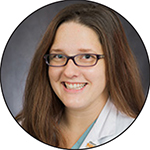
Am Fam Physician. 2023;107(2):198
Author disclosure: No relevant financial relationships.

6:30 a.m.
I am prerounding on patients in the hospital. One was admitted with a possible large pleural effusion. He is sent to interventional radiology for thoracentesis. I am concerned about the fluid because he was recently diagnosed with a rare cancer.
8:45 a.m.
I am paged that one of my obstetric patients has arrived at labor and delivery in active labor. I break away from rounds to check her in to the labor and delivery department.
11:30 a.m.
I get a call from the interventional radiologist. They could not drain the fluid from my patient's lung because there was no fluid; it was a large mass, likely metastasis. They have not told him why they were unable to perform the procedure.
12:00 p.m.
My patient in labor is doing well and is almost ready to deliver. Using an interpreter, we discuss how excited she is for her second baby. It is easy to share her excitement because I am pregnant with my second baby and due in a few weeks. After rounds, I call my other patient's oncologist to discuss this morning's findings. Unfortunately, no intervention is available, and the mass is a rapid progression of his cancer.
1:00 p.m.
I walk to my patient's room and sit by his bed. Family surrounds him. I explain the radiology findings, the cancer progression, and my discussion with his oncologist. I speak with him about hospice. We are all crying by the end of our talk. He asks me how much time he has left, and I don't know what to say. I lay my hand on his, and he nods. As I exit his room, my laboring patient's nurse pages me that the patient is pushing.
2:00 p.m.
My patient delivers a beautiful baby during an uncomplicated delivery. We celebrate. Everyone is smiling.
7:45 p.m.
I sit in the rocking chair in my daughter's room reading to her before bed. I hold her tight while we read.

8:30 a.m.
I follow up with a patient who is in renal failure and was recently in the hospital for hyperkalemia after a missed dialysis session. The patient is worried that his heart cannot handle the stress of dialysis. I perform point-of-care ultrasonography (POCUS) in the office, which shows an E-point septal separation of 75 mm, corresponding to an ejection fraction of 50%. The cardiac POCUS relieves the patient's stress and reassures me that we can wait for formal echocardiography.
9:00 a.m.
A healthy 32-year-old mom presents for repeat bilateral carpal tunnel injections. She needs surgery but has been busy with her child and career and has not wanted to take time off work, so she comes in every six months for the injections.
10:00 a.m.
A 65-year-old patient on dialysis follows up after an inpatient hospital stay for pneumonia. Her insulin has been titrated over the past few months, and her A1C is at goal. She needs a referral for a colonoscopy to get on the renal transplant list.
11:30 a.m.
I conduct a telephone visit with a 66-year-old man with diabetes mellitus who is a rancher. He was diagnosed with COVID-19 today. He would like treatment and does not have time to get sick because he needs to care for his livestock. I explain the risks and benefits and prescribe nirmatrelvir/ritonavir. He must withhold his statin for the five days of treatment.
1:00 p.m.
I see a patient for opioid dependence and migraine headaches. He has been sober for two years. He and his wife are on the verge of tears when they explain how grateful they are for our services. When I get discouraged, I think of visits like this.
4:00 p.m.
I am late for our staff meeting but feel good about caring for the prior patient. Most of the meeting is spent discussing recruitment issues. Our clinic, like others, is struggling to maintain adequate staffing. We need clerical staff, nurses, a nurse practitioner, and a family doctor.
